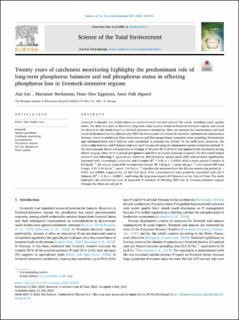| dc.contributor.author | Liu, Jian | |
| dc.contributor.author | Bechmann, Marianne | |
| dc.contributor.author | Eggestad, Hans Olav | |
| dc.contributor.author | Øgaard, Anne Falk | |
| dc.date.accessioned | 2023-11-06T16:16:10Z | |
| dc.date.available | 2023-11-06T16:16:10Z | |
| dc.date.created | 2023-09-13T13:50:12Z | |
| dc.date.issued | 2023-11-10 | |
| dc.identifier.citation | Science of the Total Environment. 2023, 898 1-9. | en_US |
| dc.identifier.issn | 0048-9697 | |
| dc.identifier.uri | https://hdl.handle.net/11250/3100890 | |
| dc.description.abstract | Livestock husbandry has raised enormous environmental concerns around the world, including water quality issues. Yet there is a need to document long-term water quality trends in livestock-intensive regions and reveal the drivers for the trends based on detailed catchment monitoring. Here, we assessed the concentration and load trends of dissolved reactive phosphorus (DRP) in streamwater of a livestock-intensive catchment in southwestern Norway, based on continuous flow measurements and flow-proportional composite water sampling. Precipitation and catchment-level soil P balance were monitored to examine the drivers. At the field level, moreover, the relationship between soil P balance and soil test P (measured using the ammonium lactate extraction method, P-AL) was assessed. Results showed that on average of 20 years 95 % of the P was applied to the catchment during March–August, when 40 % of annual precipitation and 25 % of annual discharge occurred. The low runoff helped reduce P loss following P applications. However, flow-weighted annual mean DRP concentration significantly increased with increasingly cumulative soil P surplus (R2 = 0.55, p = 0.0002). With a mean annual P surplus of 8.8 kg ha−1, the annual mean DRP concentration (range: 49–140 μg L−1; mean: 80 μg L−1) and annual DRP load (range: 0.35–1.46 kg ha−1; mean: 0.65 kg ha−1) significantly increased over the 20-year monitoring period (p = 0.001 and 0.0003, respectively). At the field level, P-AL concentrations were positively correlated with soil P balances (R2 = 0.48, p < 0.0001), confirming the long-term impact of P balances on the risks of P loss. The study highlights the predominant role of long-term P balances in affecting DRP loss in livestock-intensive regions through the effect on soil test P. | en_US |
| dc.language.iso | eng | en_US |
| dc.publisher | Elsevier B.V. | en_US |
| dc.rights | Attribution-NonCommercial-NoDerivatives 4.0 Internasjonal | * |
| dc.rights.uri | http://creativecommons.org/licenses/by-nc-nd/4.0/deed.no | * |
| dc.title | Twenty years of catchment monitoring highlights the predominant role of long-term phosphorus balances and soil phosphorus status in affecting phosphorus loss in livestock-intensive regions | en_US |
| dc.title.alternative | Twenty years of catchment monitoring highlights the predominant role of long-term phosphorus balances and soil phosphorus status in affecting phosphorus loss in livestock-intensive regions | en_US |
| dc.type | Peer reviewed | en_US |
| dc.type | Journal article | en_US |
| dc.description.version | publishedVersion | en_US |
| dc.rights.holder | © 2023 The Authors | en_US |
| dc.source.pagenumber | 1-9 | en_US |
| dc.source.volume | 898 | en_US |
| dc.source.journal | Science of the Total Environment | en_US |
| dc.identifier.doi | 10.1016/j.scitotenv.2023.165470 | |
| dc.identifier.cristin | 2174738 | |
| dc.source.articlenumber | 165470 | en_US |
| cristin.ispublished | true | |
| cristin.fulltext | original | |
| cristin.qualitycode | 2 | |

